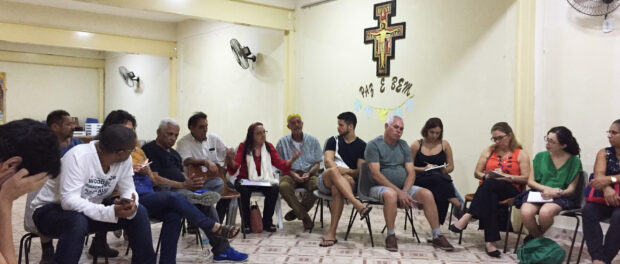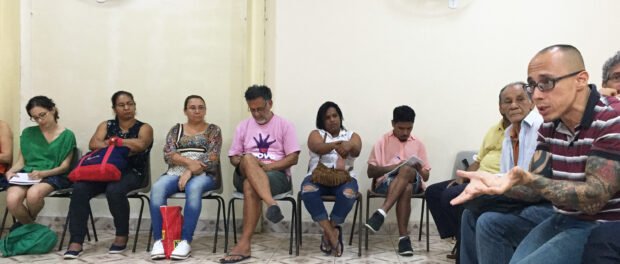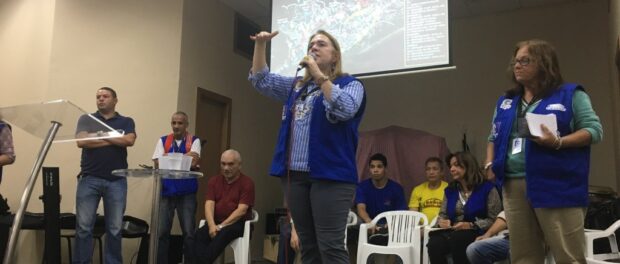
On December 14, a group of 30 residents from the favela of Rocinha, located in Rio de Janeiro’s South Zone, met at the local Parish of Nossa Senhora da Boa Viagem. Most were worried. Many feared eviction amid overambitious government development plans. For the third straight month, Rocinha Sem Fronteiras (Rocinha Without Borders) a community group that meets monthly to discuss resident issues, gathered to debate the likely massive impact of the state’s proposed Comunidade Cidade (Community City) program.
Among Governor Wilson Witzel’s campaign promises, the R$1.5 billion (US$370 million) urbanization plan will ostensibly address infrastructure and sanitation problems in three of Rio’s favelas: Rocinha; Complexo da Maré, near Rio’s international airport; and Salgueiro, in Niterói. While officials are yet to provide detailed plans, the program gained its own subsecretariat on December 16. The project is set to kick off in Rocinha, but has been given no starting date.
While Rocinha has been the recipient of dozens of urbanization and upgrading programs in the past, many were never completed, contributing to residents’ lack of trust in government authorities. Comunidade Cidade now promises to be the biggest re-urbanization project to date, and will profoundly change the shape of Rocinha over the next three years. In addition to mistrust in the government, residents now fear for the number of families threatened with eviction.

“We have to mobilize the other residents,” said one meeting participant. “The state is going to do this project in their own way. It’s going to be a political project, and it’s likely to get worse if residents just let it happen.”
Governor Witzel had announced the forced removal of some 7000 residents, and officials later confirmed that the figure applied to families rather than individuals. According to Public Defender Luiz Gustavo, present at the Rocinha Sem Fronteiras meeting, 7,400 families will be evicted to make room for Comunidade Cidade works—up to 30,000 residents. Though resident groups often count Rio’s largest favela at 200,000 residents, official data claim there are about 100,000 residents in Rocinha, meaning somewhere between one-third one-sixth of the neighborhood could face eviction.
The state maintains it will seek to provide alternative housing for those evicted in the form of 18 apartment blocks, each 10 stories high. But Gustavo warned that the proposed apartments will be insufficient to house all affected families: many will be forced to leave the community. Relocated families, meanwhile, will receive compensation based on assessments of each residence. Residents wondered if those who remain would be able to afford to live in the new apartments, given that the buildings may incur new expenses such as doormen, elevators, maintenance, and cleaning costs.
Residents are now fighting to obtain more information. Speaking at the Rocinha Sem Fronteiras meeting, Gustavo said he had requested and obtained a state-produced CD with more detailed information, but the disc turned out to be damaged and inaccessible. Comunidade Cidade project coordinator Ruth Jurberg, moreover, declined an invitation to join the discussion for the second month in a row.

Despite her refusal to speak to Rocinha residents directly (Jurberg last spoke in Rocinha in September), Jurberg recently presented Comunidade Cidade to a November seminar on Urban Planning and Land Regularization. Speaking at the EMERJ state law school in downtown Rio, Jurberg explained some of the project’s goals.
Comunidade Cidade aims to redevelop Rocinha from the top down. It will start from Vila Cruzeiro (the highest point in Rocinha) and the neighborhood of Labouriaux—which has already been threatened with evictions during the Olympics and 2019’s heavy rains—and will finish at the bottom of the favela.
Jurberg also said sanitation would be one of Comunidade Cidade’s central objectives, eating up R$1 billion. The project would aim to improve trash collection and recycling by increasing the number of collection points in Rocinha and improving the existing eleven. The project would also seek to improve Rocinha’s sewage network and water supply. Currently, the community has a number of sewage waterfalls that dramatically affect public health, and only 25% of Rocinha’s residents receive properly treated water; the project aims to increase that figure to 60%.
Officials state the plan will improve mobility in Rocinha. According to Jurberg, the program would focus on creating better road networks, improving existing routes, and creating more car-oriented roads (reducing pedestrian paths) that would enable ambulances, firemen, and trash collectors to circulate. The project plans to widen roads in dense areas in order to enhance air quality and reduce humidity.
Until plans are formed with intense resident participation, then consolidated and made official, however, Jurburg’s program description rings hollow. Residents remain sidelined from plans regarding their own communities, and while many agree on the need for Rocinha to receive improved sanitation works among other demands, families remain concerned over the only clear promise made by Comunidade Cidade officials so far: that of eviction.
